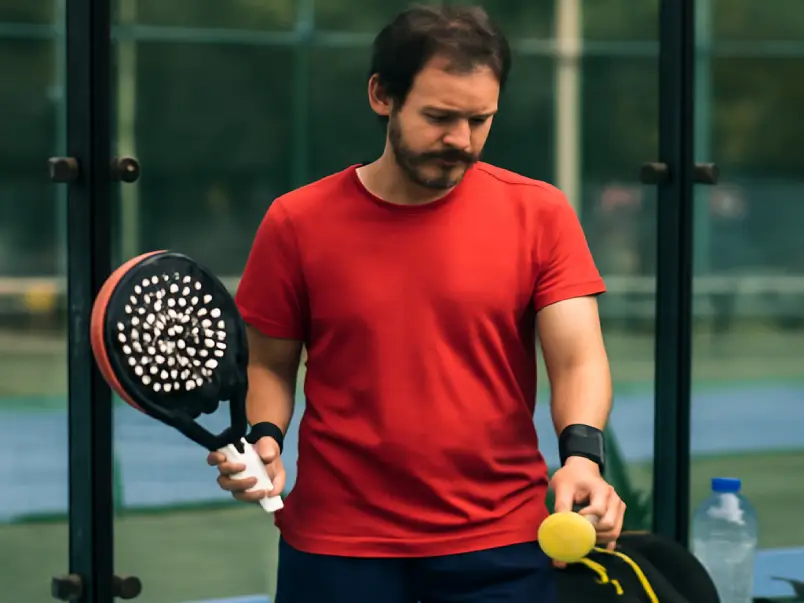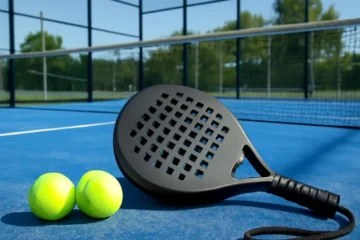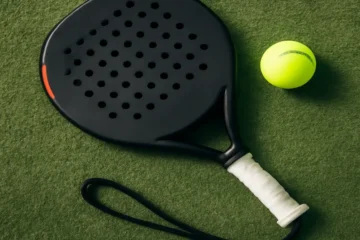The Unwritten Rules of the Court
Padel is a game full of intensity, strategy, and some, well, quirky traditions. If you’ve ever stepped onto a padel court, chances are you’ve witnessed some strange pre-match rituals or observed players performing what seem like superstitious acts during the game. Perhaps you’ve seen that one player who bounces the ball exactly three times before serving or the duo that always high-fives in the exact same way after a point. These little oddities may make you wonder: Are these superstitions or just the rituals that keep players focused?
Superstition isn’t just for other sports; it’s alive and well in the padel world. We surveyed players to uncover some of the most bizarre (and surprisingly common) rituals that players swear by. From lucky socks to specific serving routines, these quirky behaviors have become an essential part of padel players’ on-court experience. But why do they do it? Is it merely a way to pass the time or do these rituals serve a deeper psychological purpose?
In this article, we’ll explore some of the most unique and fun superstitions padel players engage in, from pre-match rituals to on-court habits. Whether you’re a seasoned player or just a fan, you’ll find that superstition plays a significant role in the game’s culture.
Part 1: The Pre-Match Rituals (Setting the Vibe)
The Lucky Outfit: The “Winning” Shirt, Lucky Socks, and More
In every sport, athletes are known for their attachment to lucky clothing. In padel, it’s no different. From shirts to socks, players often believe that a specific outfit can bring them good fortune. There’s that player who refuses to play without their “lucky” shirt—the one they wore during their best match. Or, perhaps it’s a particular pair of socks that have become their good luck charm. Some players even go as far as wearing lucky underwear!
It’s not just about the color of the clothing either. For many padel players, it’s the belief that wearing the same outfit (even when it’s getting a little worn out) can give them the edge they need to win a match. Whether it’s the lucky white socks, a specific t-shirt, or a favorite pair of shoes, these garments become much more than mere clothing—they’re symbols of success and positive energy.
The Warm-Up Routine: Rituals That Set the Tone
Before stepping onto the court, padel players have a distinct warm-up routine to help them feel ready for the match. For some, this involves hitting the ball against the glass a specific number of times to “feel” the court before the match begins. Others may prefer to start with a specific shot—a forehand or backhand—that has to be executed perfectly before they feel mentally prepared.
Stretching routines can also take on a ritualistic tone. Whether it’s a sequence of stretches performed in a certain order or a set number of lunges and squats, these routines help players mentally and physically prepare for the match. While it might seem like just another part of the preparation process, these routines can help players calm their nerves, focus their minds, and set the tone for the match ahead.
The Gear Check Obsession: A Calming Ceremony
For some padel players, the match doesn’t start until they’ve meticulously checked their gear. This could mean repeatedly checking the grip on their racket or ensuring that the ball pressure is just right. Others may need to check the court door handle multiple times before they feel ready to step onto the court.
This ritualistic gear check isn’t just about being prepared—it’s about creating a sense of control. In a chaotic game like padel, where anything can happen in an instant, players feel comforted by the predictability of their pre-match gear check. The process becomes a calming ceremony that sets their mind in the right place before the game begins.
Part 2: The On-Court Habits (During the Battle)
The Serving Ceremony: More Than Just a Serve
In padel, the serve is crucial. But for some players, it’s not just about hitting the ball over the net—it’s about how they serve. Many padel players have a unique serving routine, one that they follow religiously before every point.
Some players bounce the ball a set number of times before serving, perhaps three or five times. Others take a deep breath before making their first move or always serve from the same spot on the service line. These rituals aren’t about superstition in the traditional sense; they’re about creating a sense of calm and control, especially in high-pressure moments. By following the same steps every time, players enter a mental zone that helps them focus on their game.
The Between-Points Routine: A Sacred Walk
Padel players often have very specific rituals they perform between points. Whether it’s walking around the net in the same direction after every point or ensuring they don’t step on the court lines, these habits can help players reset and maintain their focus. The consistency of these small rituals helps players stay grounded and focused on the task at hand.
There’s also the matter of post-point celebrations. Some pairs have a particular handshake or a high-five routine after every point, regardless of whether it’s won or lost. This shared moment of celebration or commiseration can help strengthen team dynamics and bring the pair together, keeping their mental energy aligned for the next point.
The Ball Choice: Only One Will Do
In padel, players can be very particular about which ball they use during a match. Some players insist on using a specific ball from the tube for important points, believing it has more luck than the others. It might sound strange, but for many players, it’s all about the feeling they get when they hold that ball.
The act of selecting a specific ball for key moments can serve as a psychological tool, boosting the player’s confidence and focus. Whether it’s the “lucky” ball or just a personal preference, this ritual helps players feel more in control of their environment, which is essential in a sport like padel.
Part 3: The Partner & Team Dynamics (Shared Luck)
The High-Five Formula: A Non-Negotiable Ritual
When it comes to team dynamics in padel, the high-five or fist bump after every point is almost non-negotiable for many pairs. It’s not just a casual celebration; it’s a ritual that helps players reconnect, reset, and stay motivated. These small, physical moments of acknowledgment can make a significant impact on the players’ mental state, especially during long matches.
This routine fosters a sense of camaraderie between teammates and can also help reduce tension after a mistake. It’s a shared understanding that keeps players connected, reminding them that they’re in this together, win or lose.
The Strategic Huddle: Resetting After a Loss
When things aren’t going well, some teams have a ritual of quickly huddling together after losing a point. This could be as simple as a brief glance or a quick chat—sometimes, no words are spoken. The ritual itself is what counts. It’s a way of resetting mentally and emotionally, wiping the slate clean before moving on to the next point.
This “reset” can help players avoid carrying negative emotions from one point to the next, preventing a loss of focus and ensuring that they remain mentally strong throughout the match.
The Order of Play: Unwritten Rules That Must Not Be Broken
There are certain unspoken rules in padel doubles that players follow religiously. One such rule is who serves first and who receives in a specific box. For some pairs, this is a non-negotiable ritual that cannot be altered. Even when facing tough opponents or a challenging match, the order of play is sacrosanct.
This ritual can help players feel a sense of consistency and control, ensuring that their team dynamics stay in balance and that the match progresses according to a familiar rhythm. By adhering to these unwritten rules, players can maintain a level of comfort and predictability during a high-stakes game.
Part 4: The Quirkiest Confessions (You Won’t Believe These!)
While many of the rituals mentioned above are fairly common, some players have confessed to some truly bizarre superstitions. These include practices that go beyond the standard pre-match routine and into the realm of the truly unique.
Here are some of the funniest and most eccentric superstitions from padel players:
- “I have to tie my left shoe before my right shoe.”
- “I hum a specific song during changeovers to keep my mind calm.”
- “I always place my water bottle in the exact same spot, with the label facing the court.”
These quirky rituals might seem odd to outsiders, but for the players who follow them, they’re a vital part of their preparation and focus.
Part 5: The Science & Psychology of Superstition
The Illusion of Control
So, why do athletes—especially padel players—adhere to these seemingly strange rituals? One reason is the need to create a sense of control. In the fast-paced, unpredictable world of padel, these rituals provide players with a sense of predictability. By engaging in specific routines, players can reduce feelings of uncertainty and maintain their focus on the game at hand.
A Focus Tool
Superstitions and rituals also help athletes maintain focus. When you perform the same routine before each serve or between points, it helps to calm your nerves and mentally prepare for the task ahead. Routines can act as a mental reset, allowing players to compartmentalize their thoughts and block out distractions.
The Placebo Effect
The placebo effect is another key factor in the psychology of superstition. If a player truly believes that wearing a specific shirt or bouncing the ball a certain number of times helps them play better, their belief can actually improve their performance. It’s all about boosting confidence, and confidence is a powerful tool in competitive sports.
Conclusion: What’s Your Superstition?
From lucky socks to intricate pre-match rituals, padel players engage in a variety of superstitions that shape their game. While these behaviors may seem quirky or eccentric, they serve an important purpose—boosting confidence, creating focus, and providing a sense of control in an unpredictable sport. Superstition, after all, is a big part of what makes the game so exciting and unique.
What about you? Do you have any superstitions or rituals that help you perform your best on the padel court? If not, maybe it’s time to create your own!
FAQs:
What are the most common superstitions among padel players?
Common superstitions among padel players include wearing lucky shirts, specific routines before serving, and checking their gear multiple times before a match. Some players also have specific rituals like always bouncing the ball a certain number of times or using a specific ball for crucial points.
Why do padel players have rituals?
Padel players engage in rituals to create a sense of control and focus. These habits help reduce anxiety, enhance concentration, and boost confidence during the match. They often act as a mental reset, enabling players to stay calm and focused on the game.
Can superstitions actually improve a player’s performance in padel?
While superstitions may not directly influence a player’s physical ability, they can improve performance by boosting confidence and helping players get into a mental “zone.” The placebo effect can make players believe they are more likely to win when performing their rituals, which can positively impact their performance.
Are team rituals important in padel?
Yes, team rituals like high-fives, fist bumps, or brief huddles after losing a point can strengthen team dynamics. These rituals help maintain mental focus, provide emotional support, and keep players connected throughout the match.
What are some of the quirkiest superstitions in padel?
Some quirky superstitions include tying shoes in a specific order, humming a certain song during changeovers, or always placing a water bottle with its label facing the court. These unique habits help players feel more in control and focused during the game.




